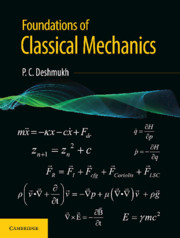Book contents
- Frontmatter
- Dedication
- Contents
- List of Figures
- List of Tables
- Foreword
- Preface
- Introduction
- 1 Laws of Mechanics and Symmetry Principles
- 2 Mathematical Preliminaries
- 3 Real Effects of Pseudo-forces: Description of Motion in Accelerated Frame of Reference
- 4 Small Oscillations and Wave Motion
- 5 Damped and Driven Oscillations; Resonances
- 6 The Variational Principle
- 7 Angular Momentum and Rigid Body Dynamics
- 8 The Gravitational Interaction in Newtonian Mechanics
- 9 Complex Behavior of Simple System
- 10 Gradient Operator, Methods of Fluid Mechanics, and Electrodynamics
- 11 Rudiments of Fluid Mechanics
- 12 Basic Principles of Electrodynamics
- 13 Introduction to the Special Theory of Relativity
- 14 A Glimpse of the General Theory of Relativity
- Index
4 - Small Oscillations and Wave Motion
Published online by Cambridge University Press: 06 November 2019
- Frontmatter
- Dedication
- Contents
- List of Figures
- List of Tables
- Foreword
- Preface
- Introduction
- 1 Laws of Mechanics and Symmetry Principles
- 2 Mathematical Preliminaries
- 3 Real Effects of Pseudo-forces: Description of Motion in Accelerated Frame of Reference
- 4 Small Oscillations and Wave Motion
- 5 Damped and Driven Oscillations; Resonances
- 6 The Variational Principle
- 7 Angular Momentum and Rigid Body Dynamics
- 8 The Gravitational Interaction in Newtonian Mechanics
- 9 Complex Behavior of Simple System
- 10 Gradient Operator, Methods of Fluid Mechanics, and Electrodynamics
- 11 Rudiments of Fluid Mechanics
- 12 Basic Principles of Electrodynamics
- 13 Introduction to the Special Theory of Relativity
- 14 A Glimpse of the General Theory of Relativity
- Index
Summary
I will be the waves and you will be a strange shore.
I shall roll on and on and on, and break upon your lap with laughter.
And no one in the world will know where we both are.
—Rabindranath TagoreBOUNDED MOTION IN ONE-DIMENSION, SMALL OSCILLATIONS
Rise and fall, ups and downs, profit and loss, success and failure, happiness and sorrow—almost every experience in life seems to be in a state of oscillation. It is the undulations of the sound waves in air which enable us to hear each other, and it is undulations of the electromagnetic waves in vacuum which bring energy (light) from the stars to us. Quantum theory tells us that there is a wave associated with every particle, and that leaves us with absolutely nothing in the physical world that is not associated with oscillations. Oscillations of what, where and how can only be a matter of details, but there is little doubt that the physical universe requires for its rigorous study an understanding of ‘oscillations’. Oscillations are repetitive physical phenomena, which swing past some event, back and forth. They are ubiquitous, and they maintain things close to some mean behavior, at least most of the times. Whether it is the breeze jiggling the leaves, the rhythmic beating of the heart that is the acclamation of life itself, the gentle ripples on a river bed, or the mighty tides in the oceans, or for that matter fluctuations in the share market, we are always dealing with some expression of the simple harmonic oscillator, or a superposition of several of these, however, complex.
We have learned in earlier chapters that equilibrium, defined as motion at constant momentum, sustains itself when the object is left alone, completely determined by initial conditions. Departure from equilibrium is accounted for by Newton's equation of motion (second law), or equivalently (as we shall see in Chapter 6) by Lagrange's, or Hamilton's equations. In a 1-dimensional region of space, say along the X-axis, we consider a region in which the equilibrium of a particle may change because of spatial dependence of its interaction with the environment. This is represented by a space-dependent potential V(x).
- Type
- Chapter
- Information
- Foundations of Classical Mechanics , pp. 111 - 155Publisher: Cambridge University PressPrint publication year: 2019



